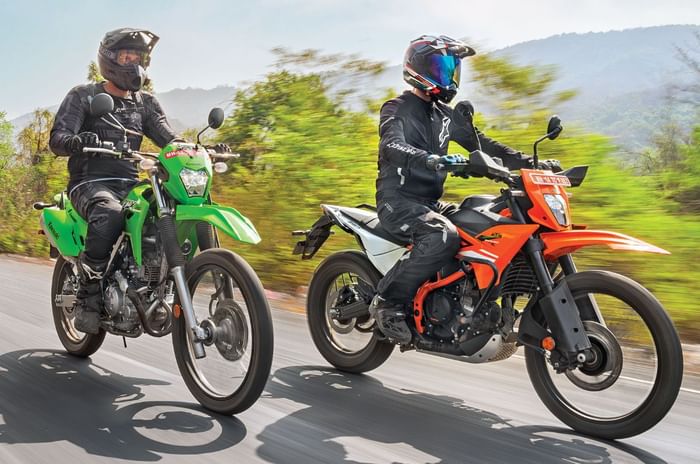Despite having a huge delta in performance, both the KTM 390 Enduro R and Kawasaki’s KLX230 are rather close in terms of pricing. We tell you which one is the better performer in terms of fuel efficiency.
While Kawasaki launched the KLX230 sometime last year, KTM recently introduced the 390 Enduro R. Both motorcycles are geared towards off-road riding but have a very different approach towards achieving this as we learnt in our comparison test. Fuel efficiency is hardly a strong consideration at this price point but given the fact that both motorcycles have rather small fuel tanks, it plays an important role in how much usable range you can expect. The figures you see here are from our fuel efficiency tests.
- KTM 390 Enduro R is equipped with a 399cc motor that produces 46hp and 39Nm
- Kawasaki’s KLX230 weighs 38kg less and makes nearly half the power
KTM 390 Enduro R vs Kawasaki KLX230 real world fuel efficiency test
390 Enduro R mileage is 31.14kpl
In our real world tests, we discovered that the 390 Enduro R returned a decent 27.48kpl in the city and managed a reasonable figure of 34.8kpl on the highway. Combine the figures and we get a respectable average fuel efficiency figure of 31.14kpl.
The KLX230 is more efficient than the KTM 390 Enduro R
On the other hand, Kawasaki’s KLX230 returned an impressive figure of 39.7kpl in the city and an even better 42.26kpl figure on the highway. Combined, the KLX230 returns an average figure of 40.98kpl.

The results show that when it comes to real-world fuel efficiency, the KLX230 is the more efficient motorcycle of the two. While these tests were conducted on public roads while adhering to local speed limits under a sedate riding style, the results can differ once you hit the dirt. However, during the course of the comparison review, we discovered that under spirited riding the smaller engine in the KLX230 consumes a lot more fuel and it was often the case that the Kawasaki needed to be filled sooner than the KTM. Under mixed riding conditions, the KTM could extract as much as 190-200km from a tankful while the Kawasaki was usually around 10-20km less than that.

While the smaller capacity and lighter weight of the KLX230 helps keep the fuel consumption low for most commutes, a change in pace reveals the larger capacity KTM feels more at ease at higher speeds and uses less fuel to hold triple digit speeds. Given that both these motorcycles are designed for more than just one riding style, it is worth noting that the results could vary depending on the type of terrain and style you choose. Another valuable piece of information is that the KLX has a fuel gauge while the KTM only gets a low fuel warning light as well as a distance to empty readout that activates once the low fuel level is reached
KTM 390 Enduro R vs Kawasaki KLX230 price and specifications
| KTM 390 Enduro R vs Kawasaki KLX230 price and specs | ||
|---|---|---|
| KTM 390 Enduro R | Kawasaki KLX230 | |
| Engine | 399cc, liquid-cooled, single-cyl | 233cc, air-cooled, single-cyl |
| Power | 46hp at 8,500rpm | 18.1hp at 8,000rpm |
| Torque | 39Nm at 6,500rpm | 18.3Nm at 6,400rpm |
| Gearbox | 6-speed | 6-speed |
| Fuel capacity | 9 litres | 7.6 litres |
| Kerb weight | 177kg | 139kg |
| Price (Rs, ex-showroom) | Rs 3.37 lakh | Rs 3.30 lakh |
The KTM 390 Enduro R gets a much larger 399cc, liquid-cooled single-cylinder engine that produces an impressive 46hp and 39Nm. It is also equipped with a slightly larger 9 litre fuel tank in comparison. Factor that with the minor price delta between the two and the Enduro R makes quite a strong case for itself.
Meanwhile Kawasaki’s KLX230 is powered by a smaller 233cc. air-cooled single-cylinder engine that produces 18.1hp and 18.3Nm. Additionally, it gets a smaller 7.6 litre fuel tank which may seem quite less, but when you factor in the smaller motor and lighter weight of the KLX230, it is fair to say it is bound to be the more fuel efficient motorcycle, or so it would seem.
Autocar India’s fuel-efficiency testing
Our fuel-efficiency testing routine starts by first brimming the tank and ensuring the bike is running the manufacturer’s recommended tyre pressures. The bike is then ridden on fixed city and highway routes, where we maintain average speeds that best mimic real-world scenarios as well as keeping speed limits in mind. The payload on the bikes is kept constant by balancing rider weights and ballast, ensuring consistency across different vehicles and riders. At the end of the test cycle, the fuel tank is once again filled to the brim, giving us an accurate figure of how much fuel has been consumed against the trip meter reading.
Also see: ADV motorcycles with the lowest seat height under Rs 4 lakh

